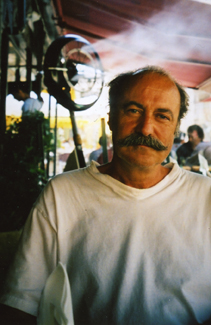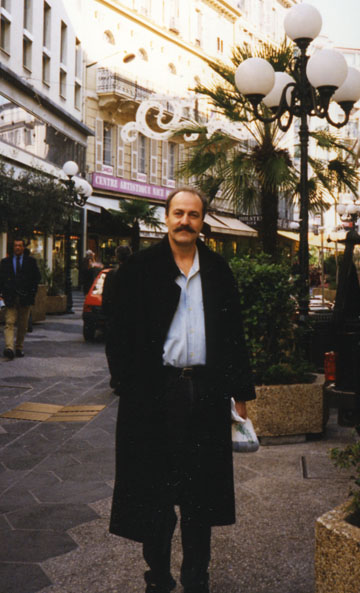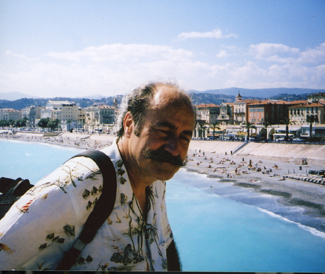BiographyDaniel P. Izzard (1949-2018) was an extraordinary man. He was a painter. His paintings are brilliant. They are eagerly collected. Daniel P. Izzard’s pedigree and credentials as an artist are impeccable.
The son of renowned painter and master impressionist Daniel
J. Izzard R.C.A., and an Honours graduate of the Ontario College
of Art and Design, Daniel was born in Ireland. As a young man,
he accompanied his father on many sketching trips; these experiences
are deeply imbedded in his memory. Daniel grew up in an environment
where art was a serious, demanding and daily endeavour. Decades
later, the small boy is still present in the humour and the quirky
detail in his work that most adult eyes filter out. Time and light
behave differently in Ireland; attuned to their elastic qualities early
in life, Daniel’s senses remained acutely open to both.
The Izzard family like so many others settled in Canada. Daniel was no stranger to duality. As a young man, he entered the high-pressure world of film and commercial art direction becoming a highly respected director/cameraman. His work in this field was extremely successful and was recognized internationally among the best, receiving many of the industry’s most coveted awards including a 'Worlds Best’ at the Hollywood Radio and Television Bureau Awards. Throughout his career in the film industry, Daniel’s painting was the other life to which he returned daily. His solitary, contemplative existence as a painter balanced the collaborative, yet highly competitive nature of the film world. Daniel’s decision to withdraw from the industry at the pinnacle of his career and to commit his life to painting was in large measure an homage to his childhood sketching expeditions and to his early lessons about the nature of time and light. Travelling in Europe, Daniel at 18 years of age found himself in the Mediterranean regions of France and Italy and recognized he was utterly at home, so much so that he worked locally for some months allowing him to fully experience this remarkable part of the world. Throughout the south of France, Italy and Corsica, Daniel responded viscerally to his surroundings. The sense of recognition was mutual. The Corsicans, fiercely proud and independent islanders, welcomed him, accepting his appreciation of the landscape as their due. An exhibition of his Corsican paintings was mounted in Porticcio. The highly successful vernissage, which was opened by the Mayor, was an occasion of tremendous civic pride – and astonishment – for the local residents, many of whom were incredulous that Daniel had painted not only their beloved olive trees but even the wild pigs, which are widely maligned by most Corsicans. One of the most interesting aspects of Daniel's work is the scale; he loved to work big, on average 40 by 48 inches, but depending on the subject and the intended location of the piece, all the way up to 8 by 12 feet. This allowed him to explore the subtle counterchange of colour, texture, light and shade, warm and cool, many of these issues would be imp A large body of work is perhaps his most vibrant—a collection of numerous paintings of Italy and most notably Venice. These are astounding works, particularly so because of the nature of Venice itself, its complexity and visual variety due to the nature of reflections in mirror-like water and the rich colour palette Venice offers. This island city intersected by canals poses a number of unique challenges for an artist. Daniel’s mastery of water in its many varieties is evident in how he has brought the canals to life, reflecting the colourful buildings looming above them and the sleek boats that line their banks. His boats are spectacular: sinister dark gondolas cleaving the water contrasting with the rich-hued wooden vessels of Venetian daily life. Each painting in this collection is even more luminous than the previous one, making the task of choosing a favourite painting almost impossible. The Venice paintings resonated deeply with individuals who responded to Daniel’s passionate relationship with a city that is in itself a metaphor for rebirth at once mysterious, beautiful and historic. The collection sold out almost immediately. Rural France and Italy had not escaped Daniel's attention. His intimate knowledge of those special out of the way places offers a look at a real world very much in the here and now yet with a strong reverence for the past and a way of life many people can only imagine. Rich in color and texture, these subjects inspired Daniel to deconstruct light and its behavior as it bounces, reflects and illuminates the details he so keenly observes in this environment. This aspect of Daniel's work is evident in his powerful and loving paintings of the Canadian wilderness, which much like his other subjects is composed of water, wood and stone. It becomes evident that Daniel had spent a great deal of time observing nature, particularly water and sky. The interaction of these two elements is truly remarkable in Daniels work and offers a unique view of the world not as a static composition but of a moving, breathing environment.
His portraits, which include family groups, children and adults, successfully capture the character and essence of the subject, always with an affectionate, mischievous tweak that brings the portrait to life. This is perhaps the characteristic that most closely sums up his paintings – the sense of life that makes the viewer feel present in the picture. |


 ossible to deal with in a smaller format. This aspect of Daniels work allows the viewer to virtually step into these amazing paintings.
ossible to deal with in a smaller format. This aspect of Daniels work allows the viewer to virtually step into these amazing paintings. In addition to placescapes as Daniel liked to refer to them, many of his paintings depict living creatures, not the least of which are his evocative portraits of some of his favorite friends. With the same quirky vision, attention to detail and subtle humour Daniel loved to paint cows, chickens, pigs, dogs and cats, even geese and bison all of which become heroic or ironic or just downright beautiful within the confines of these amazing canvases.
In addition to placescapes as Daniel liked to refer to them, many of his paintings depict living creatures, not the least of which are his evocative portraits of some of his favorite friends. With the same quirky vision, attention to detail and subtle humour Daniel loved to paint cows, chickens, pigs, dogs and cats, even geese and bison all of which become heroic or ironic or just downright beautiful within the confines of these amazing canvases.